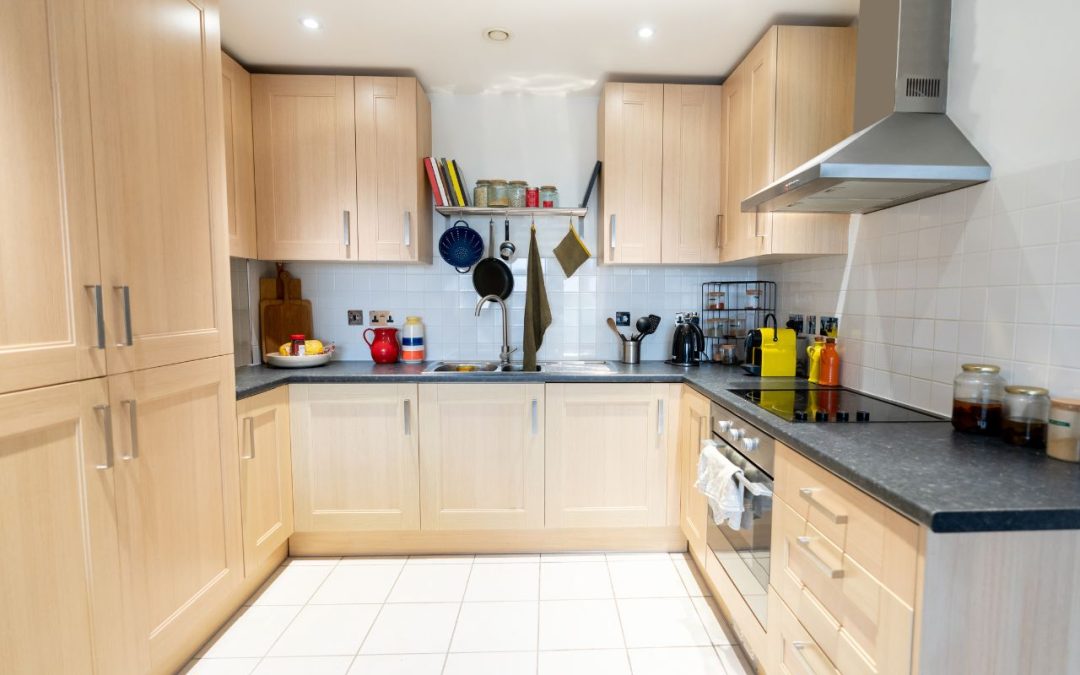
10 Small-Kitchen Storage Ideas to Maximize Your Space
In small kitchens, storage challenges often accompany tight layouts, necessitating creative solutions to make the most of every available inch. The limited space requires careful consideration and efficient organization to ensure optimal functionality. While it’s tempting to try storing as much as possible, overloading a tiny kitchen can exacerbate the feeling of confinement. Therefore, the first crucial step is decluttering. Evaluate and streamline your collection of cookware, dishes, glassware, utensils, and small appliances, retaining only the essentials.
Once decluttered, strategic storage solutions can enhance the functionality of a small kitchen. Utilize vertical space by installing shelves or cabinets that extend to the ceiling. Consider pull-out or pull-down storage features to maximize accessibility to deep cabinets. Use hooks, racks, or magnetic strips to store utensils, pots, and pans, freeing up valuable drawer and cabinet space. Opt for stackable containers and nested bowls to make the most of limited cabinet space. Customized drawer dividers can help organize cutlery and utensils efficiently.
Incorporate multifunctional furniture, such as a kitchen island with built-in storage or a foldable dining table that can serve as additional workspace. Wall-mounted shelves or pegboards offer flexible storage options for frequently used items. Compact and stackable storage solutions, like nesting bowls or collapsible containers, help optimize space.
Consider incorporating open shelving for a visually appealing and accessible storage solution. Transparent containers or glass-fronted cabinets can create an illusion of openness and make it easier to locate items.
By combining decluttering with these smart storage solutions, you can transform a small kitchen into an organized and efficient workspace without compromising on style or functionality.
1. Install open shelving.
In a small kitchen, optimizing storage is essential for maintaining an organized and functional space. One effective strategy is to install open shelves, transforming underutilized walls into valuable storage zones. Open shelving provides an opportunity to display and access frequently used items such as dishware, cookbooks, and pantry staples with ease.
To make the most of this storage solution, consider incorporating hooks along the lower part of the shelves. These hooks offer an additional space to hang items like mugs or utensils, efficiently utilizing vertical space and keeping countertops clutter-free. This simple yet practical project not only enhances storage capacity but also adds a decorative element to the kitchen.
By embracing open shelving and cleverly positioned hooks, you can elevate your kitchen’s functionality in a visually appealing manner. This approach maximizes storage potential, creating a more spacious and organized feel within the constraints of a small kitchen.
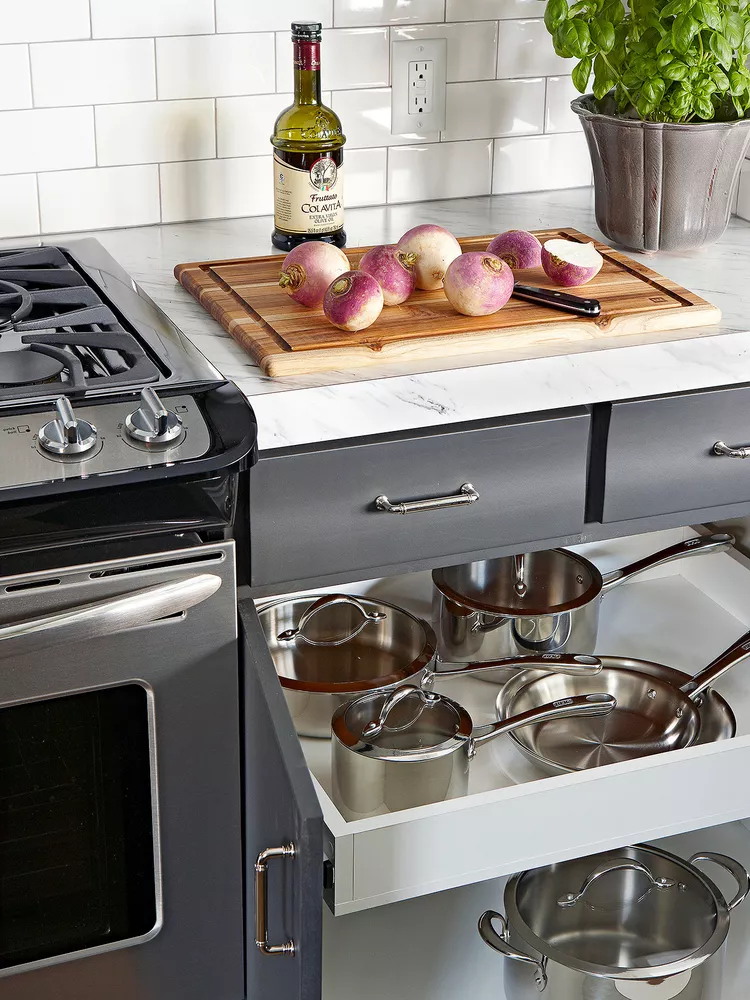
2. Incorporate pullout storage.
In a small kitchen, maximizing storage is essential for maintaining order and functionality. Clever storage solutions can transform a cramped space into an organized and efficient cooking area.
One effective strategy is to implement open shelves. By installing these on available walls, you create a stylish storage zone for various items, such as dishware, cookbooks, and pantry ingredients. This not only adds a decorative touch but also provides easy access to frequently used items. Consider adding hooks along the bottom of the shelves to hang mugs or utensils, further optimizing the storage capacity.
Additionally, customizing kitchen cabinets with features designed for convenience can significantly enhance storage. Pullout shelves or drawers make use of awkward cabinet spaces, ensuring that items stored at the back are easily reachable. This is particularly beneficial for organizing bulky pots and pans, keeping them in proximity to the cooking area.
To make the most of available space, it’s crucial to declutter and only keep essential items. Pare down cookware, dishes, glassware, small appliances, and utensils, retaining those that are regularly used. This initial step creates a foundation for effective storage solutions.
By combining open shelves, customized cabinets, and thoughtful decluttering, a small kitchen can be transformed into a compact, organized workspace. This approach not only maximizes storage but also contributes to an aesthetically pleasing and functional kitchen environment.
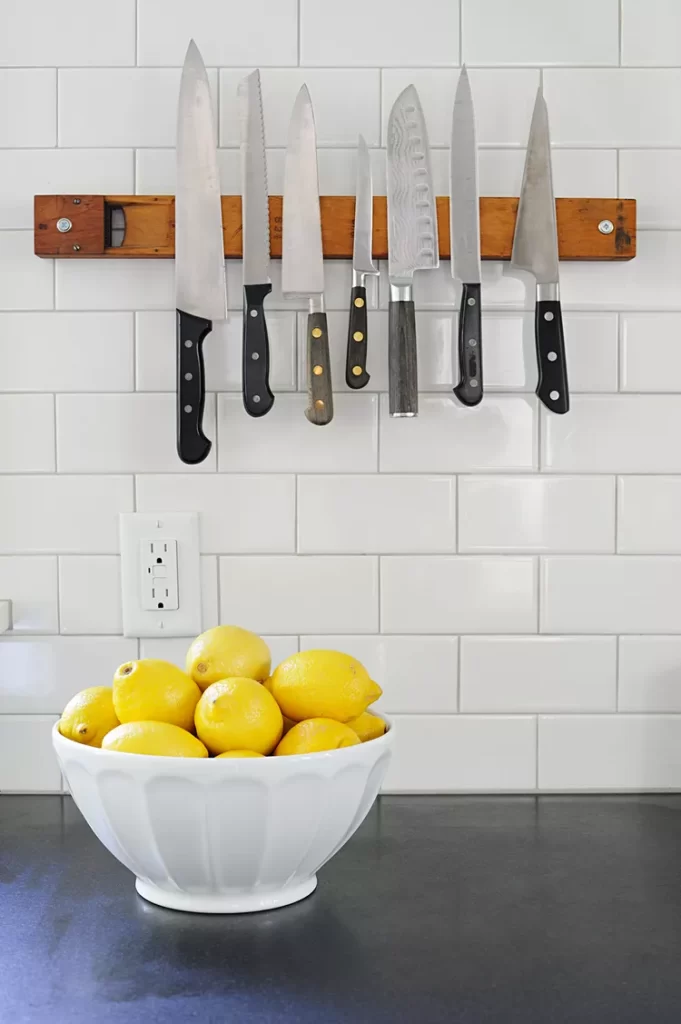
3. Utilize walls for knife storage.
Upgrade knife storage in your small kitchen by replacing the traditional knife block with a wall-mounted magnetic strip. This innovative small kitchen storage idea allows you to keep your frequently used knives easily accessible while saving valuable counter space. Install the magnetic strip near your prep area for convenient access, enabling you to quickly grab the necessary knife for chopping and slicing ingredients. This solution not only declutters your countertop but also adds a contemporary and functional element to your kitchen decor.
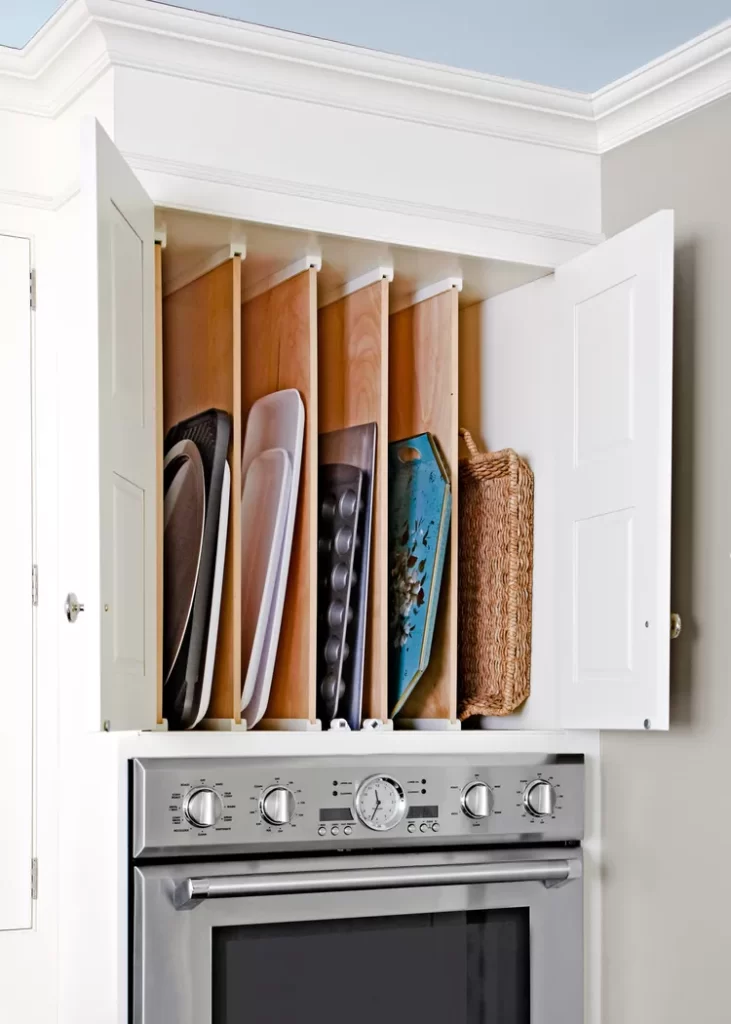
4. Divide cabinet space.
In small kitchens, efficient storage solutions are crucial to make the most of limited space. Implementing strategic storage ideas can transform a cramped kitchen into a well-organized and functional workspace.
- Maximize Vertical Space: Utilize vertical space by installing open shelves on walls. These shelves can store dishware, cookbooks, and pantry items, creating a stylish storage zone. Adding hooks along the bottom of a shelf allows you to hang mugs or utensils for additional organization.
- Custom Cabinetry Features: Enhance storage within kitchen cabinets by incorporating custom features. Pullout shelves or drawers make use of awkward cabinet space and provide easy access to items in the back. This solution is particularly useful for storing bulky pots and pans near the range.
- Under-Cabinet Storage: Make the most of under-cabinet space by adding hooks or racks. Hang items like mugs, utensils, or even small baskets for storing spices. This helps free up counter space and keeps frequently used items within reach.
- Magnetic Knife Strip: Replace a bulky knife block with a wall-mounted magnetic strip. This small kitchen storage idea keeps knives easily accessible without occupying counter space. Mount the knife holder near the prep area for convenient access during cooking.
- Cabinet Dividers: Incorporate dividers inside cabinets to organize cookware and bakeware. Horizontal or vertical dividers are ideal for storing baking sheets and narrow pans separately. This prevents clutter and allows you to quickly retrieve the item you need without rummaging through stacks.
- Declutter and Prioritize: Before implementing storage solutions, declutter your kitchen by keeping only essential items. Prioritize what you use regularly, and consider donating or storing items not frequently used.
By applying these small kitchen storage ideas, you can create an organized and efficient kitchen that maximizes space and functionality.
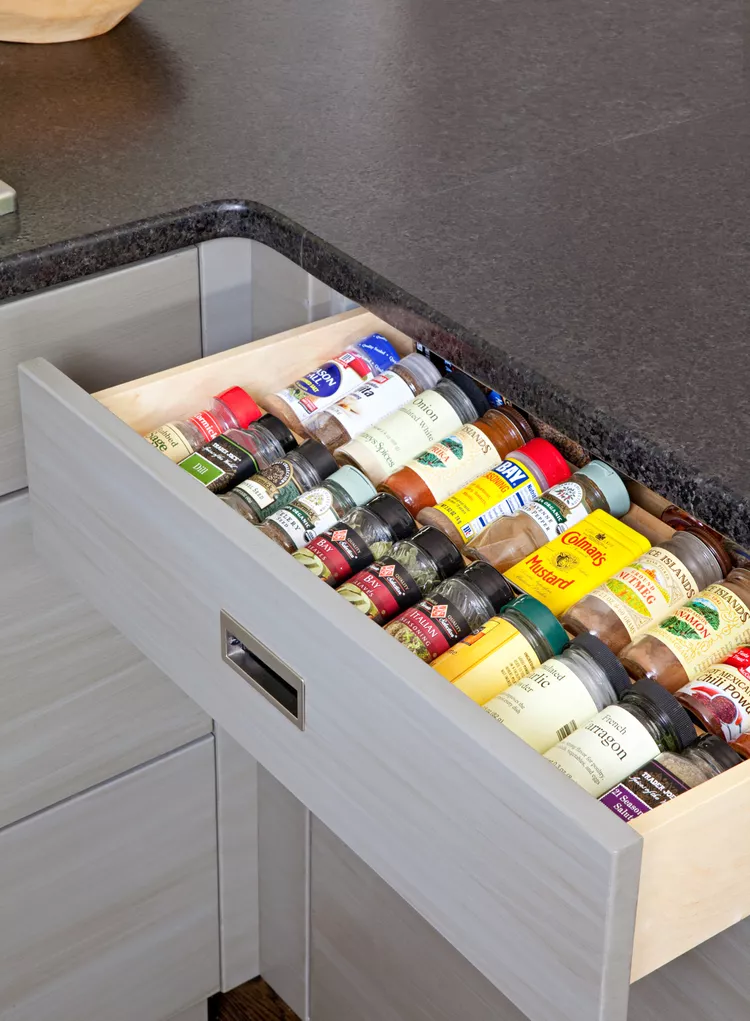
5. Rethink spice storage.
Organizing small containers of spices and herbs can be a challenge in a kitchen, often leading to a jumbled mess inside cabinets or pantries. To streamline access and maintain order, consider dedicating a specific space for spice storage. Here’s a suggestion: allocate a small drawer or a sliver of cabinet space specifically for organizing your spices.
- Drawer Spice Organizer: Opt for a drawer organizer designed for spice storage. These organizers often feature slots or compartments that can hold spice canisters in an upright position. This arrangement not only prevents spills but also makes it easy to read labels and identify spices quickly.
- Easy Accessibility: By designating a drawer or a dedicated cabinet area for spices, you create a centralized and easily accessible location for your entire spice collection. This eliminates the need to sift through cluttered shelves, providing a more efficient cooking experience.
- Labeling System: Implement a labeling system to further enhance organization. Clearly label each spice canister with its name or use a color-coded system to identify different categories of spices. This ensures that you can quickly locate the specific spice you need during meal preparation.
- Compact Storage: Utilizing a dedicated drawer or cabinet space for spices allows for a compact and organized storage solution. It prevents overcrowding and makes it easier to maintain order, preventing spices from getting lost or forgotten in the depths of a pantry.
- Customizable Options: Explore customizable spice storage options that fit the dimensions of your chosen drawer or cabinet space. There are various organizers available, including adjustable inserts that can accommodate different-sized spice containers.
By implementing a designated space for spice storage and using a purpose-built organizer, you can maintain a tidy and accessible collection of spices in your kitchen. This not only streamlines your cooking process but also adds a touch of organization to your culinary space.
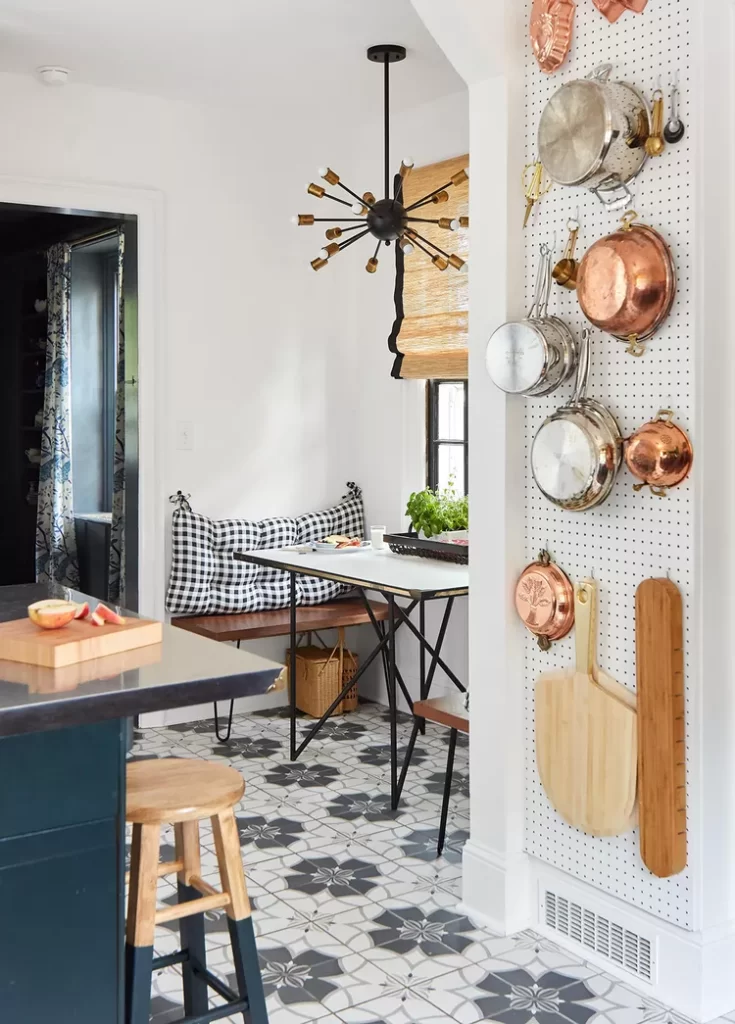
6. Use pegboards for multi-purpose kitchen storage.
Indeed, using a pegboard as a storage solution in a small kitchen can be a practical and versatile approach. Pegboards offer a customizable and flexible way to organize various kitchen items, making the most of limited space. Here are some additional tips and considerations for using a pegboard in your small kitchen:
- Installation:
- Ensure the pegboard is securely attached to the wall or cabinet door. Use appropriate anchors and screws to support the weight of your kitchen supplies.
- Make sure the pegboard is level to maintain a neat and organized appearance.
- Hooks and Accessories:
- Invest in a variety of hooks and accessories that suit your specific needs. There are different types of hooks designed for holding pots, pans, utensils, cutting boards, and more.
- Consider using shelves, baskets, or containers that can be hung on the pegboard to store smaller items or ingredients.
- Grouping Items:
- Group similar items together on the pegboard to create designated zones for different kitchen functions. For example, have a section for cookware, utensils, and cutting boards.
- Arrange items based on frequency of use, placing frequently used items within easy reach.
- Aesthetics:
- Consider painting or decorating the pegboard to match your kitchen decor. This can enhance the overall look and make it more visually appealing.
- Arrange items in a visually pleasing way to create an organized and tidy appearance.
- Adaptability:
- Regularly reassess your storage needs and adjust the pegboard accordingly. This adaptability is one of the key advantages of using this storage solution.
- As your kitchen tools or equipment change, easily move or add hooks to accommodate the new items.
- Clearing Counter Space:
- Utilizing vertical space with a pegboard can help free up valuable counter space, making your small kitchen feel more open and functional.
- Hang frequently used items on the pegboard to keep them easily accessible.
- Maintenance:
- Periodically clean the pegboard and items hanging on it to prevent dust and grease buildup.
- Ensure that the hooks and attachments are secure to avoid any accidental falling or damage.
By implementing these tips, you can maximize the efficiency of your small kitchen using a pegboard, creating a well-organized and visually appealing storage solution.
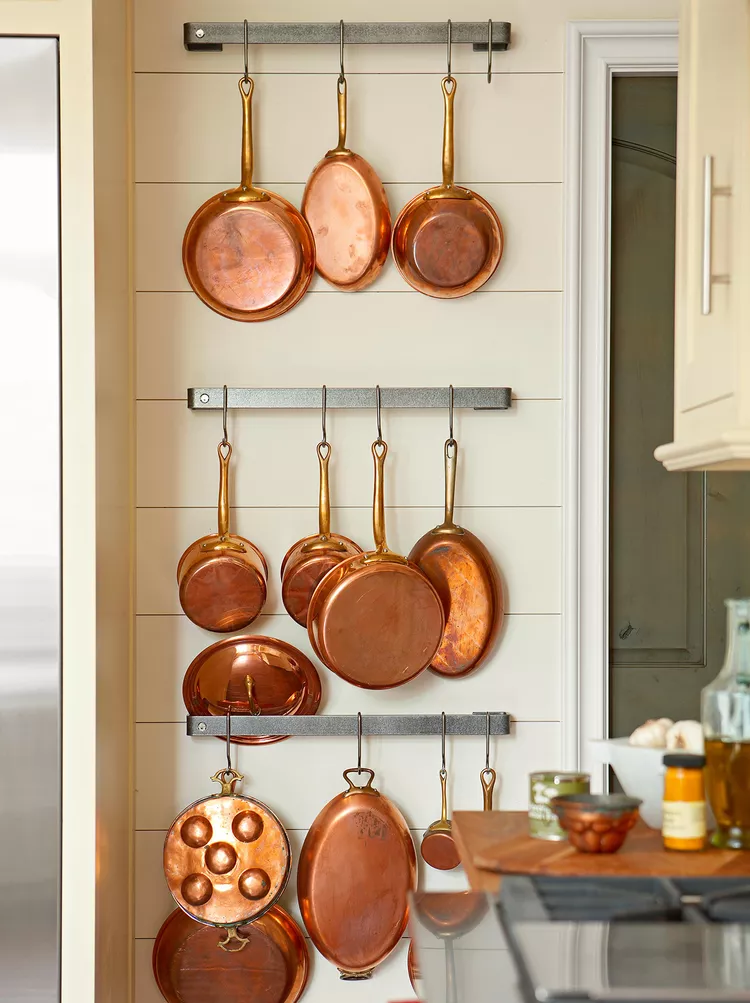
7. Customize cookware storage.
Absolutely, using a simple metal bar, whether in the form of a pot rack or a sturdy wall-mounted bar, is an effective and space-saving solution for small kitchens. Here are some additional insights and tips for optimizing storage with a metal bar:
- Strategic Placement:
- Mount the metal bar in a convenient and accessible location, such as near the prep area or above the cooktop. This ensures that pots and pans are within easy reach during cooking.
- Weight Capacity:
- Ensure that the metal bar has the necessary weight capacity to support your cookware. This is particularly important for heavy pots and pans. If needed, choose a bar with reinforced brackets or additional support.
- S-hooks or Hanging Mechanism:
- Use S-hooks or a similar hanging mechanism to suspend pots and pans from the metal bar. S-hooks are versatile and allow for easy rearrangement of cookware.
- Consider using adjustable hangers that can accommodate different sizes and shapes of cookware.
- Display and Organization:
- Arrange pots and pans in a visually appealing way, creating a functional and decorative display. This not only serves a practical purpose but also adds aesthetic value to your kitchen.
- Utilizing Vertical Space:
- Hanging cookware on a metal bar takes advantage of vertical space, freeing up cabinets and counters for other kitchen essentials. This is particularly beneficial in small kitchens where space is limited.
- Accessibility and Efficiency:
- Organize cookware based on frequency of use, placing the most frequently used items at eye level for easy access. This enhances the efficiency of your kitchen workflow.
- Maintenance:
- Regularly clean the metal bar and cookware to prevent dust and grease buildup. This ensures that your kitchen remains both functional and visually appealing.
- Consider Dual Functionality:
- Some metal bars or pot racks come with additional shelving or hooks for storing other kitchen items, such as utensils or cutting boards. This dual functionality maximizes storage space.
Using a metal bar in your small kitchen not only provides practical storage for cookware but also adds an element of style and organization. It’s a versatile solution that can be adapted to various kitchen layouts and design preferences.
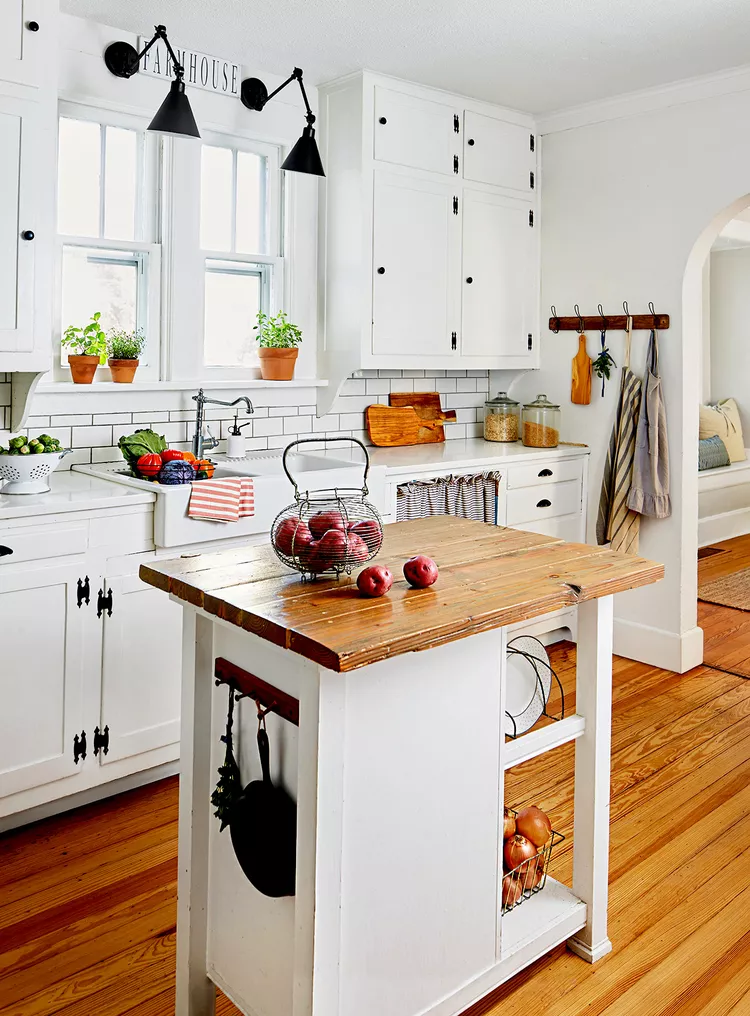
8. Design a small kitchen island.
Integrating a well-designed island into a small kitchen can indeed provide additional prep and storage space, along with flexibility. Here are some tips for making the most of a small kitchen island:
- Customized Size and Height:
- Tailor the size and height of the island to your specific needs and the available space. A compact yet functional island can make a significant difference in a small kitchen.
- Multifunctional Design:
- Opt for an island with built-in storage solutions, such as shelves, drawers, or cabinets. This allows you to keep kitchen essentials organized and within reach.
- Hooks and Bins:
- Enhance the functionality of the island by incorporating hooks and bins. Hooks can be used for hanging utensils, towels, or small pots and pans, while bins provide storage for produce, kitchen tools, or other items.
- Mobile or Portable Options:
- Consider using an island on casters for increased flexibility. This allows you to move the island out of the way when not in use or during social gatherings, providing a more open kitchen space.
- Foldable or Drop-Leaf Design:
- If space is at a premium, choose an island with a foldable or drop-leaf design. This allows you to expand the surface area when needed and fold it down when extra space is not required.
- Material Selection:
- Choose materials that complement your kitchen’s aesthetic while also being durable and easy to clean. Popular choices include butcher block, granite, or quartz for the countertop and a mix of materials for the base.
- Lighting Integration:
- Install task lighting above the island to create a well-lit workspace. Pendant lights or under-cabinet lighting can be effective in illuminating the area for food preparation.
- Customizable Add-ons:
- Explore additional add-ons and accessories that suit your needs, such as built-in spice racks, knife blocks, or even a wine rack. These features maximize the island’s utility.
- Clearing Clutter:
- Regularly declutter the island to maintain a functional and organized space. Avoid overcrowding the surface with unnecessary items to ensure it remains a practical workspace.
- Utilize Underneath Space:
- If the island has an open base, consider using the space underneath for additional storage or installing hooks for hanging items like pots or kitchen tools.
By incorporating these tips, you can create a small kitchen island that not only expands your prep and storage space but also adds versatility and style to your kitchen layout.
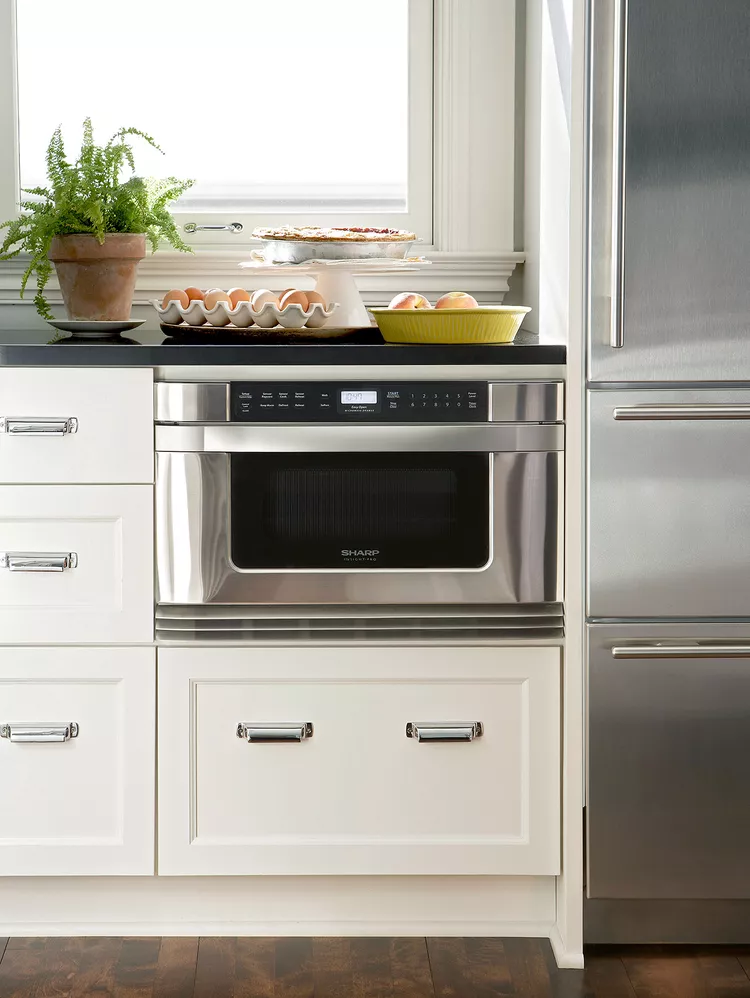
9. Select small kitchen appliances.
Absolutely, small appliances play a crucial role in the efficiency and functionality of a kitchen, particularly in small spaces. Undercounter microwaves and multi-functional appliances can be valuable additions. Here are some considerations and tips for making the most of small appliances in a compact kitchen:
- Undercounter Microwaves:
- Space Optimization: Placing the microwave under the counter frees up valuable countertop space, making the kitchen feel less cluttered.
- Ergonomics: Undercounter microwaves are typically installed at a more accessible height, making it easier to transfer hot food without the risk of spills.
- Combination Microwave and Convection Oven:
- Versatility: Opting for a combination microwave and convection oven provides versatility in cooking options. It can serve as a traditional microwave for reheating and defrosting, while also functioning as a convection oven for baking and roasting.
- Space-Saving: Combining two functions in one appliance saves counter and storage space, making it an efficient choice for small kitchens.
- Compact Appliances:
- Consider Size: When selecting small appliances, consider their size in relation to the available kitchen space. Compact versions of blenders, food processors, and coffee makers can perform essential tasks without taking up excessive room.
- Stackable or Nesting Appliances:
- Storage Efficiency: Look for appliances that can be stacked or nested when not in use. This can be particularly beneficial for items like mixing bowls, measuring cups, or other kitchen tools.
- Mountable Appliances:
- Wall-Mounted Options: Explore the possibility of wall-mounting certain small appliances, such as can openers or coffee grinders, to further save counter space.
- Hideaway or Pull-Out Solutions:
- Appliance Garages: Consider incorporating appliance garages or pull-out shelves into your kitchen design. These spaces can hide small appliances when not in use, maintaining a clean and organized look.
- Appliance Multiplicity:
- Choose Multi-Functional Appliances: Select appliances that serve multiple purposes. For instance, a stand mixer with various attachments can replace the need for several individual gadgets.
- Compact Storage Solutions:
- Utilize Vertical Space: Install shelves, racks, or organizers on the walls or inside cabinets to efficiently store small appliances without taking up precious counter space.
- Cord Management:
- Tuck Away Cords: Keep cords organized and out of the way. Some appliances come with cord storage features, or you can use cord organizers to prevent tangling.
By strategically choosing and organizing small appliances in a small kitchen, you can maximize efficiency, maintain a tidy workspace, and create a more enjoyable cooking and entertaining experience.
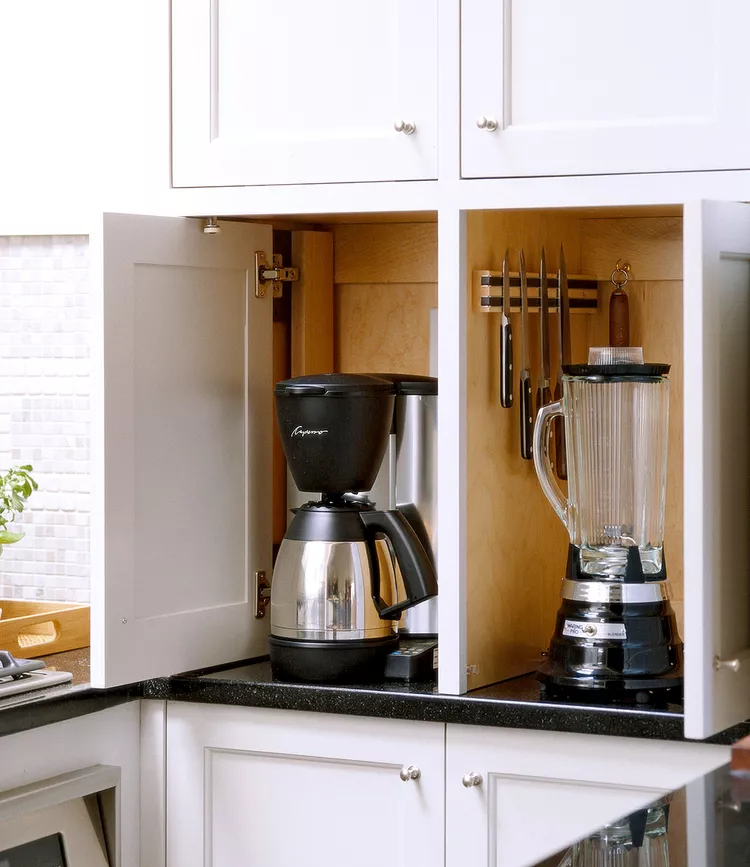
10. Disguise bulky countertop appliances.
Absolutely, appliance garages are excellent additions to a kitchen, especially in small spaces, as they help keep countertop appliances neatly stored and out of sight. Here are some considerations and tips for optimizing appliance garages in your kitchen:
- Door Orientation:
- Side-to-Side or Up-and-Down Doors: The choice between side-to-side or up-and-down doors depends on your kitchen layout and preferences. Side-to-side doors may be more suitable for smaller appliances, while up-and-down doors can provide easier access to taller items like blenders or stand mixers.
- Space Planning:
- Consider Appliance Sizes: When designing the appliance garage, consider the size and height of the appliances you intend to store. Ensure that the garage can accommodate various items without wasted space.
- Electrical Outlets:
- Built-In Outlets: To enhance convenience, consider adding electrical outlets within the cabinets where the appliance garage is located. This allows you to easily plug in and use appliances without having to pull them out onto the countertop.
- Adjustable Shelves:
- Customizable Storage: If possible, incorporate adjustable shelves within the appliance garage. This allows you to customize the storage space based on the height of your appliances and provides flexibility as your needs change.
- Ventilation:
- Ensure Adequate Ventilation: Some appliances, such as toasters or coffee makers, generate heat during use. Ensure that the appliance garage has proper ventilation to dissipate heat and prevent damage to stored items.
- Lighting:
- Add Interior Lighting: Consider installing LED lights inside the appliance garage to improve visibility when retrieving or storing appliances. This can be especially useful if your kitchen lacks sufficient natural light.
- Accessibility:
- Easy Access: Design the appliance garage for easy access. Smooth-gliding or pull-out shelves can make it more convenient to reach appliances stored at the back.
- Matching Cabinet Style:
- Seamless Integration: Choose cabinet doors and finishes that match the overall style of your kitchen. This ensures a seamless and cohesive look when the appliance garage is closed.
- Incorporate Charging Stations:
- For Small Electronics: If you store small electronic devices like phones or tablets in the appliance garage, consider incorporating charging stations for added convenience.
- Conceal Clutter:
- Maintain a Neat Appearance: The primary purpose of an appliance garage is to keep countertop appliances out of sight when not in use. Ensure that the garage doors close properly to maintain a tidy appearance in your kitchen.
By implementing these tips, you can effectively utilize appliance garages to keep your kitchen organized and maximize countertop space in smaller kitchen environments.
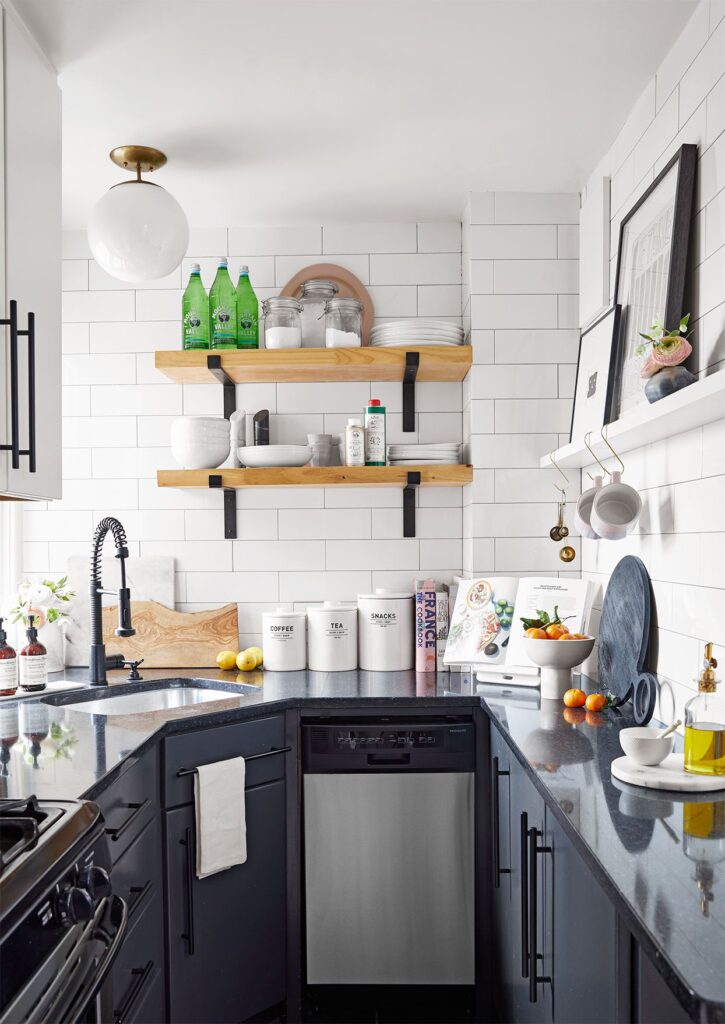
Conclusion
In transforming a small kitchen into a functional and organized space, various strategies can be employed. Pegboards offer a versatile storage solution, allowing for the repositioning of hooks to accommodate changing storage needs efficiently. Metal bars and pot racks prove effective in storing cookware, while small kitchen islands provide additional prep and storage space, especially when designed with flexibility, such as islands on casters. Undercounter microwaves and multi-functional appliances, like combination microwave and convection ovens, help save countertop space. Appliance garages with side-to-side or up-and-down doors offer concealed storage for countertop appliances, with the added convenience of built-in electrical outlets. Overall, the key is to prioritize adaptability, organization, and strategic storage solutions to make the most of limited kitchen space.


